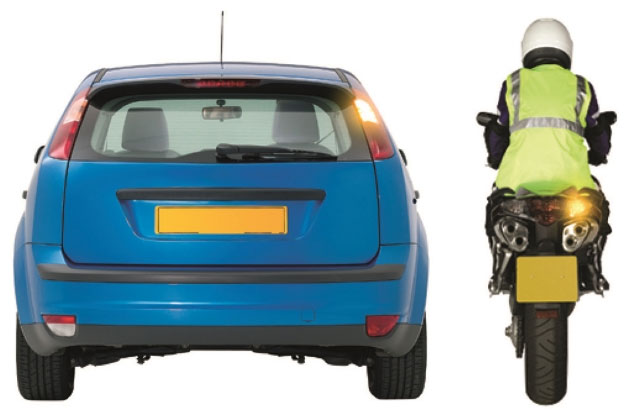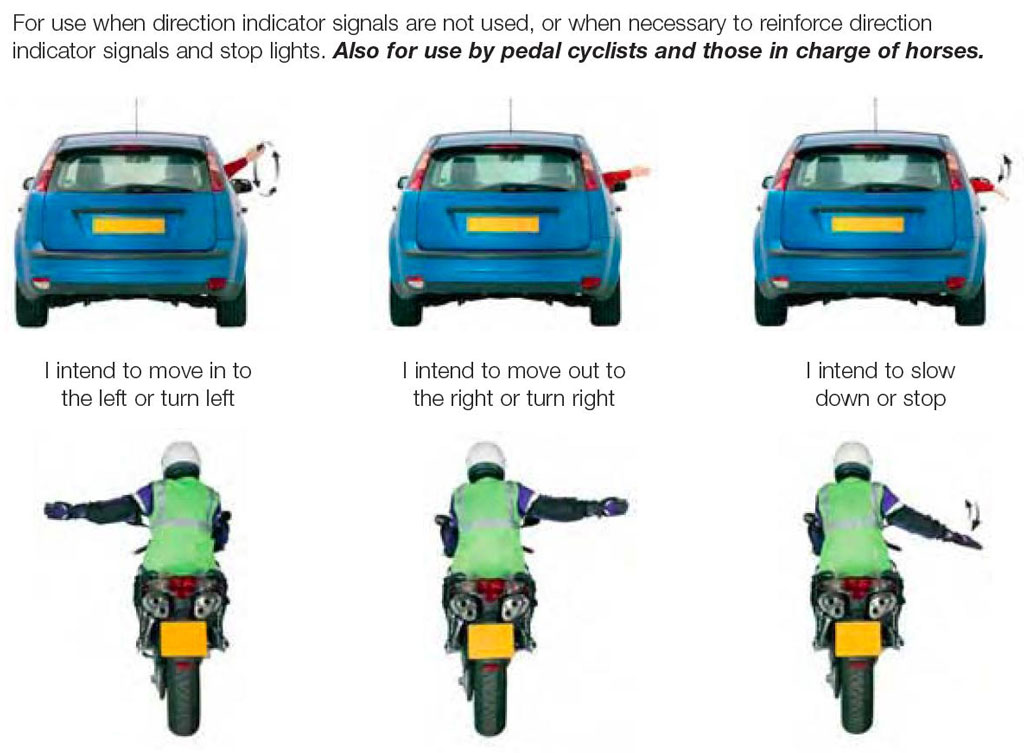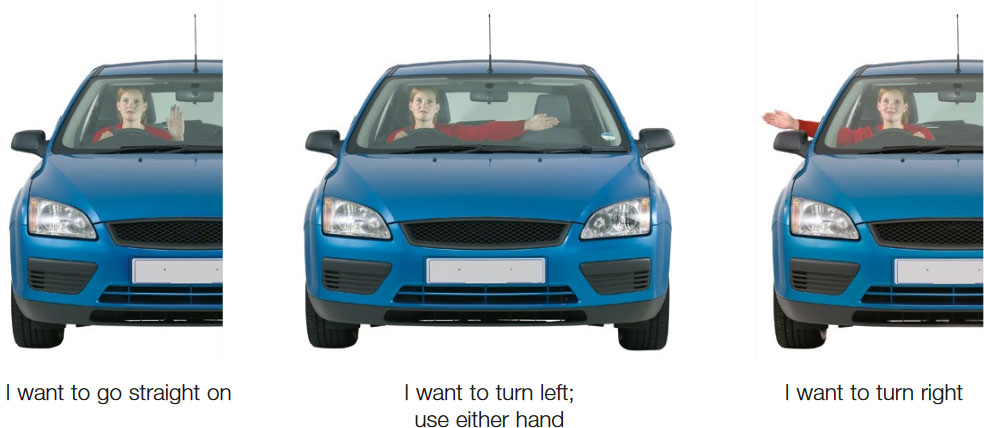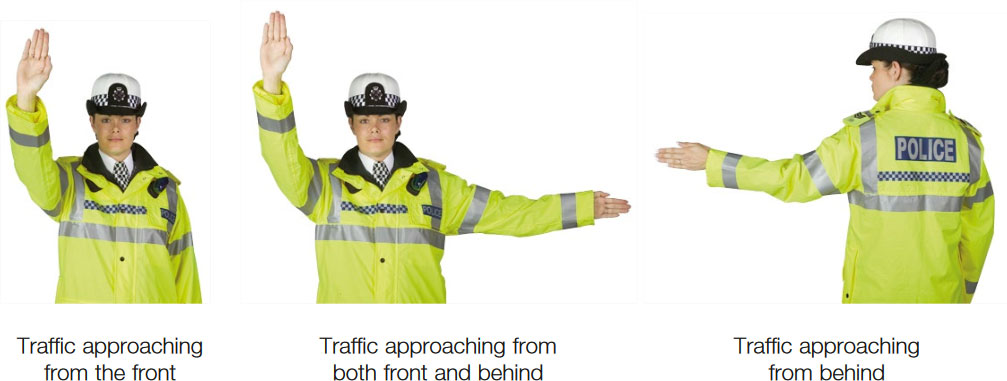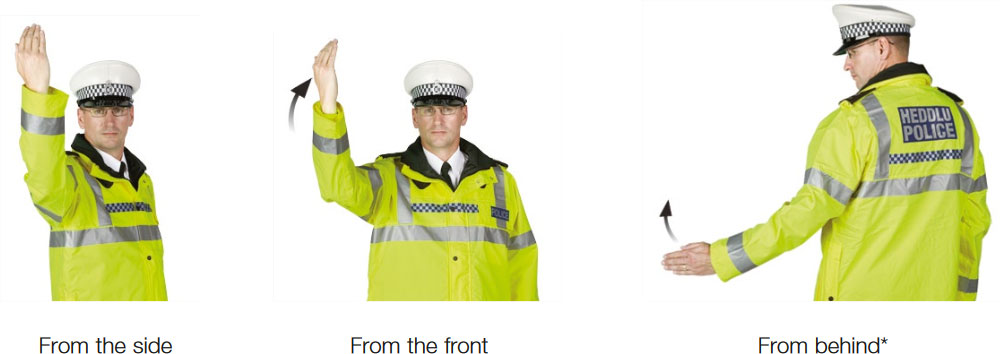Contents
The correct use of signals is a key element in safe driving. Getting the right balance of signalling when it is appropriate so that drivers know what you are intending to do, whilst not over signalling is important. The driving test examiner will be looking to see if you know when it is appropriate to signal and will want to make sure that you don’t signal unnecessarily or at the wrong time.
In this article, we will run through the different signals that you use as a driver and how you should use them properly.
How to Use Direction Signals

The most common signals used when driving are the brake lights and the direction indicators. To use signals properly you need to always make sure you check your mirrors before you signal, this is so you can make the decision that it is safe to make the manoeuvre you wish to make before you indicate to other drivers that you are going to do this.
The correct use of signals are:
- To indicate to other drivers and pedestrians what you are going to do
- To be courteous to all other drivers and pedestrians
- To be used at the correct time so that others have time to respond appropriately
The correct use of direction indicators is to inform other drivers and pedestrians that you are intending to change the direction you are currently moving in. This could be either when you are turning, emerging, overtaking, changing lanes or if you are moving off or pulling over.
When is it unnecessary to use a signal?
Signalling needs to be done correctly, otherwise, you can confuse other drivers and pedestrians. The question you need to ask yourself is, will someone benefit from my signal? Ask yourself this every time you are either about to move off or are coming to a stop. Check your mirrors to see if there is someone behind you and if there is give them the correct signal to let them know what you are about to do.
It is important that you do not signal too soon, as this can be confusing to other road users. Sitting at the side of the road with your signal on as you are waiting to be able to move off is not the correct use of your indicators. You should only put on your indicator as you are about to move off.
Another occasion where it is unnecessary to signal is when driving past vehicles that are parked at the side of the road. In these instances, you need to plan ahead – check your mirrors and move out so that you can pass the vehicle. Your position on the road will indicate to other road users what your intentions are and they will know that you are going to pass the parked cars.
How to Time your Signals
Perfecting the timing of your signals takes a bit of practice, but it will soon become second nature. The correct timing of signals is particularly important when you are turning or emerging, overtaking another moving vehicle or changing lanes.
For example, if you are intending to take the second road on the left do not signal until you pass the first road on the left. If you signal too early in this instance the cars behind you will think you are turning sooner than you yourself intend to do so. It can also be dangerous – if there is someone waiting to pull out from the first road on the left they may pull out in front of you thinking that you are turning into their road.
There are some early indications you can give to drivers behind you that you are intending to turn soon, without putting your indicator on too early. It may be the case that the car behind you is driving very close and you are worried that they may go into the back of you when you need to slow down to turn. In this instance, you can start to gently brake as you get closer to the turning, and if the first left is clear of emerging vehicles you could signal a little earlier.
It is all about being able to read the situation you are in and knowing how to respond in the safest possible way. As you drive more and more it will become a lot easier to signal correctly as you gain experience. Use your common sense and think about how other drivers will interpret the signals you are making.
Remember to always turn your indicator off once you have completed your movement.
How to Signal with Brake Lights
Your brake lights are an automatic signal that come on whenever you engage the brake pedal. Always keep an eye out for brake lights ahead of you as this indicates to you that you are likely to need to slow down also. Make sure you check your mirrors before slowing down.
To inform other drivers that you are intending to change direction or come to a stop, you should press your foot brake gently early on so that the drivers behind you are aware that you are slowing down.
Brake lights are incredibly important, so it is essential to check that they are working regularly. You can do this by checking your vehicle’s reflection in windows or garage doors, or you can ask a friend to check your brake lights while you press the brake pedal. It is a good idea to keep some spare bulbs in the car in case your brake lights fail.
When to use the Horn
The correct way to use the horn is as a means of warning other drivers and pedestrians that you are there if you think that they cannot see you. This might be if a pedestrian is crossing the road and you believe that they are not aware of your presence. Or if you are driving around a blind bend you can use the horn to warn other drivers that you are there.
Make sure you only apply little beeps of the horn rather than a long loud press as this can sound aggressive. The horn should not be used when you are aggravated because another driver has done something you are not happy with. Do not use your horn when the car is stationary (unless there is an emergency) and avoid using the horn in residential areas between 11.30 pm and 7 am.
The Meaning of Flashing Headlights
When a driver flashes their headlights at you it can be for a number of reasons. Drivers should flash their headlights to let someone know they are there if the horn will not be heard, or if it is during the hours when the horn should not be used.
Drivers may also be flashing their headlights at you to thank you, to let you emerge before them, to inform you that you need to put your lights on or that your lights are too bright, to warn you that there is something wrong with your car, or that there is a hazard ahead. It can be for any number of reasons.
You should not flash your lights to put pressure on other drivers or to let them out of a junction as this needs to be their own decision.
How to Use and Read Arm Signals
https://www.youtube.com/watch?v=eWx578Y7iSA
Drivers use arm signals very infrequently, but it is good to know the meaning of the signals just in case you need to interpret or use them.
These are the other arm signals that drivers use to other drivers:
- Left turn= Right arm out and rotating forward
- Right turn = Right arm out and palm facing forward
- Slow down or stop = Right arm out, palm down and moving up and down
These are the arm signals that a driver can give to traffic controllers:
- Left turn = put your left arm out to the side
- Right turn = put your right arm out to the side
- Straight ahead = lift up your left arm in the air, as shown in the picture below
On some occasions, perhaps when the traffic lights have failed or there is an obstruction in the road, you will need to know how to interpret the arm signals of the traffic controller.
These images are telling drivers to STOP from different directions:
- Image one is stopping traffic approaching from the front
- Image two is stopping traffic approaching from the front and behind
- Image three is stopping traffic approaching from behind
These images are to Beckon Traffic On from different directions:
- Image one is beckoning traffic on from the side
- Image two is beckoning traffic on from the front
- Image three is beckoning traffic on from behind
Below are the signals given by School Crossing Patrols:
- Image one tells pedestrians not to cross
- Image two tells pedestrians to get ready to cross, and drivers to be ready to stop
- Image three is the barrier to inform pedestrians to stop crossing
- Image four tells all vehicles that they must stop.
Conclusion
Getting the hang of the different types of signals, when to signal and when not to signal can seem a little daunting when you are first learning to drive. However, with practice and common sense, you will soon perfect the technique. Remember to only signal when you are ready to make the movement you intend to make and only signal if another driver or pedestrian will benefit from it.



